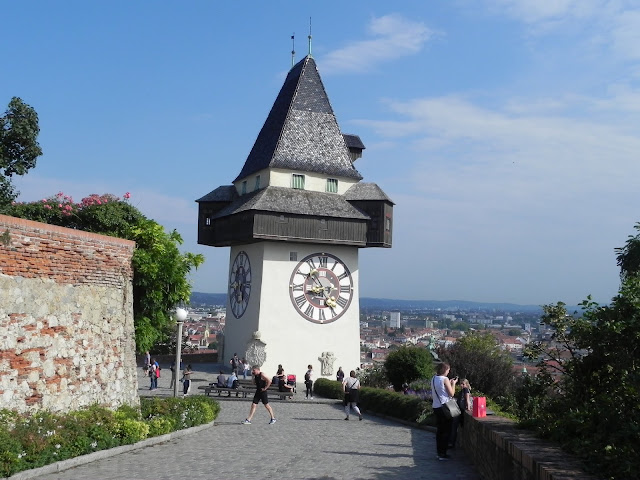Austria's capital of Vienna was just a little too far out of range for a day trip from our timeshare in Schladming. Austria's second-largest city, however, was not. So one morning we all loaded into the rental car and drove to Graz.
In addition to being Austria's second-largest city, Graz is also the capital of the Styria state. And while it might not be as well-known as places like Vienna or Salzburg, there's still plenty worth visiting there, including some rather quirky features.
Like many European cities, Graz developed around a large hill, atop of which was a fortress. However, the fortress is no longer there; some guy from France had it demolished in 1809. A few things remain, including a clock tower. The Urhturm took its present shape sometime in the 1500s and is an icon of Graz:

From the top of the Schlossberg there is an excellent view of the city (as well as a really cool Biergarten). The Uhrturm is to the left. and that weird black thing to the right is the Kunsthaus Graz, a modern art museum built in 2003:

Here's my father standing in front of the Kunsthaus, which is also known as the "Friendly Alien:"

Near the Kunsthaus is another piece of modern architecture floating in the Mur River. The Murinsel also dates to 2003 (the year Graz served as the European Capital of Culture) and contains an outdoor amphitheater as well as an indoor cafe:

Here's what the Murinsel looks like on the inside. The cafe contains a bar as well as a stage:

Graz Cathedral was built between 1438 and 1462 by the Holy Roman Emperor, Frederick III:

The interior of the cathedral is built in a gothic architectural style and is ornately beautiful:
 Across the street from the cathedral is an old municipal building notable for its double spiral staircase with two separate flights that diverge and then converge back upon one another at each floor. Corinne and I climbed it and decided that it was interesting, but probably caused a lot of people bumping into each other as they went up and down it back in the day:
Across the street from the cathedral is an old municipal building notable for its double spiral staircase with two separate flights that diverge and then converge back upon one another at each floor. Corinne and I climbed it and decided that it was interesting, but probably caused a lot of people bumping into each other as they went up and down it back in the day:
The Grazer Landhaus was built in 1527 by Italian Renaissance architect Domenico dell'Allio and features a delightful arcaded courtyard. The Styrian state parliament still meets in this complex; the Styrian Armory is located here as well:
Adjacent to the Landhaus is the Rathaus, or city hall, of Graz. It was completed in 1893 and faces the Hauptplatz, which is the city's main square:
Herrengasse (literally, "Street of the Lords") is Graz's historic main street. It passes by the Hauptplatz, Rathaus and Landhaus, and is lined by stores. Several streetcar lines run along it. (Interesting fact: "next station" announcements on Graz's streetcars are in German and American English, rather than the British accent you would normally expect to hear in Europe. Maybe it's Graz's way of throwing shade at Britain because of Brexit?) One point of interest along Herrengasse is the Painted House, seen to the left:
Heading back to the train station on the edge of the town center, there is a monument erected to commmorate the hundredth anniversary of Esperanto in 1987. It reads "the hope for world communication in piece and freedom." (Next to the monument is cafe Das Esperanto; sadly, the menu is not actually printed in Esperanto, which I found to be a huge disappointment):
 All in all, an interesting trip to an interesting city. We spent a full day there and still didn't see anything close to everything Graz has to offer. Because it is off the beaten path, so to speak, there were not crushing numbers of tourists in Graz. We found this a welcome respite from Venice, Dubrovnik, Athens and even Salzburg.
All in all, an interesting trip to an interesting city. We spent a full day there and still didn't see anything close to everything Graz has to offer. Because it is off the beaten path, so to speak, there were not crushing numbers of tourists in Graz. We found this a welcome respite from Venice, Dubrovnik, Athens and even Salzburg.Graz has an airport served by short-haul flights, a major train station and is accessible via autobahns A-2 and A-9 (if you're only visiting by car for the day, park close to the train station; it's not the cheapest parking in town but there's plenty of it and it's very convenient). While you're there, take advantage of their excellent public transportation network to get around. A 24-hour pass is €5.30 while a three-day ticket is €12.40. Graz is also bicycle-friendly. Knowledge of basic German helps, of course, but we found that a decent number of people that we came across in Graz spoke English.



